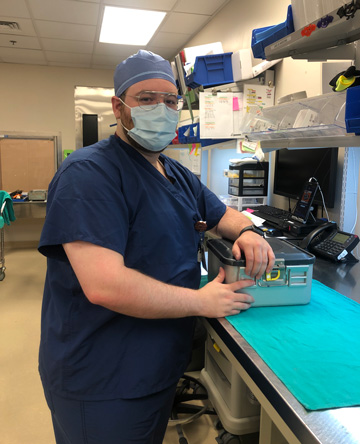Meeting guidelines for product identification and traceability, record-keeping and monitoring of chemical sterilization.
Standards provide healthcare providers with a set of requirements, specifications and guidelines established and agreed upon by industry experts as the gold standard of care. In the United States, the American National Standards Institute Inc. (ANSI) and the Association for the Advancement of Medical Instrument (AAMI) are recognized authorities and sources of consensus standards for the medical device industry.
For sterilization guidance, there are two primary ANSI/AAMI documents that provide what OR teams need to make good choices about their facility's sterilization processes. These include ANSI/AAMI ST79:20171 which is a comprehensive guide to steam sterilization and sterility assurance for facilities. NSI/AAMI ST58:2013/(R)20182 was developed by the AAMI and approved by the ANSI in 2013. It provides standards and recommended practices specifically for the use of low temperature chemical sterilization and high-level disinfection in a healthcare facility. Standard 58 (ST58) covers a broad range of topics including work area design considerations (Section 3), decontamination and preparation of instruments (Section 6), and using chemical sterilant safely and effectively (Section 7).
Advanced Sterilization Products (ASP) can help meet AAMI quality control recommendations specifically for ST58 (Section 9) for cycle documentation and record-keeping through the company's built-in scanner and touch-screen interface that facilitate input of BI (biological indicator), sterilizer and load information, which reduces the need for manual record-keeping.
Together, STERRAD® Systems and STERRAD VELOCITY® fill this need which is discussed in ST58 (Section 9). This covers product identification and traceability, documentation and record-keeping, monitoring of chemical sterilization, product testing, product recalls and quality process improvement.
Another important guideline section, ST58 (Section 9), focuses on using biological indicators and process challenge devices. The AAMI recommendation states "health care personnel should use the BIs and PCDs recommended by the manufacturer of the selected gaseous chemical sterilization system and cleared by the FDA for use with that sterilization system or BIs and PCDs cleared by the FDA as substantially equivalent."2
Here, ASP can also help meet this guideline as the manufacturer of STERRAD® Systems, and only recommends the use of the STERRAD VELOCITY® System with its sterilizers. STERRAD ELOCITY® BI/PCDs were developed by ASP using exclusive proprietary data and technology which results in accurate results and minimizes false positives.
Finally, ST58 (Section 9) also focuses on the frequency of the use of biological indicators and process challenge devices. The AAMI Recommendation states, "A PCD with the appropriate BI should also be used at least daily, but preferably in every sterilization cycle."2 The condition of the sterilizer equipment, the expertise of the sterilizer operator and other factors determining the success or failure of a sterilization cycle could vary from one cycle to another.
ASP can help meet this guideline with STERRAD VELOCITY® BI/PCD, the only all-in-one Process Challenge Device for STERRAD® Systems that meets AAMI recommended guidelines. This means that when you run a STERRAD VELOCITY® BI/PCD in a sterilization cycle, the load is automatically challenged to a level equal to or greater than your most difficult device to sterilize.
Additionally, ST58 (Section 9) discusses the qualification test procedure with BIs. The recommendation includes these guidelines:
a) Before being exposed to the sterilization cycle, the PCD should be labeled with appropriate sterilizer lot and load information.
b) The PCD should be positioned in the load or chamber according to the sterilizer manufacturer's written IFU, and a normal cycle should be run.
c) Upon completion of the sterilization cycle, the manufacturer's written IFU for removing the PCD from the load or chamber and the BI from the PCD should be followed. The BI should be identified and then incubated according to the IFU of the BI manufacturer.
d) Each day that test BIs are run, at least one BI that is from the same lot and that has not been exposed to the sterilant should be incubated as a control to verify the pre-sterilization viability of the test spores, the ability of the media to promote growth of the test spores, and the proper incubation temperature. Test and control lot numbers should be recorded. Upon completion of the incubation period, the test and control results should be read and recorded. If the control BI from a lot fails to grow, it should be assumed that the test BIs from that lot are not viable or that improper incubation occurred. Therefore, the results from the test BIs should be considered invalid and the test should be repeated.
ASP can help meet this guideline with the STERRAD VELOCITY® System, which guides users through compliant biological indicator (BI) processing and automatically creates audit-ready records and can store up to 22,000 complete records including the information recommended by AAMI.
Note: Sophia Czechowicz, PhD, is ASP's Associate Director, R&D — Technical Business Solutions and she leads ASP's Technical Business Solutions R&D team in support of the development, implementation and use of ASP products and technologies for reprocessing medical devices. She authored this article on guidelines for sterilization (see: https://www.asp.com/media/sophia-czechowicz-phd).
For more information, visit www.asp.com.
References:
1. American National Standard/Association for the Advancement of Medical Instrumentation. ANSI/AAMI ST79:2017 Comprehensive guide to steam sterilization and sterility assurance in healthcare facilities.
2. American National Standard/Association for the Advancement of Medical Instrumentation. ANSI/AAMI ST58:2013/(R)2018 Chemical sterilization and high-level disinfection in health care facilities.
 FINAL CHECK Sterile processing techs should make sure all instruments are accounted for and properly sterilized during the reassembly process.
FINAL CHECK Sterile processing techs should make sure all instruments are accounted for and properly sterilized during the reassembly process.
.svg?sfvrsn=be606e78_3)


.svg?sfvrsn=56b2f850_5)